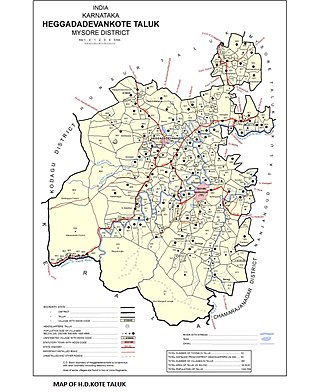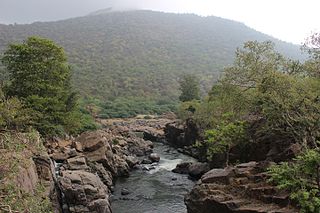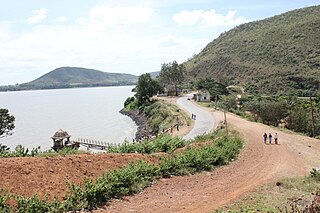
The Kaveri is one of the major Indian rivers flowing through the states of Karnataka and Tamil Nadu. The Kaveri River rises at Talakaveri in the Brahmagiri range in the Western Ghats, Kodagu district of the state of Karnataka, at an elevation of 1,341 m above mean sea level and flows for about 800 km before its outfall into the Bay of Bengal. It reaches the sea in Poompuhar, in Mayiladuthurai district. It is the third largest river – after Godavari and Krishna – in southern India, and the largest in the state of Tamil Nadu, which, on its course, bisects the state into north and south. In ancient Tamil literature, the river was also called Ponni.

Vani Vilasa Sagara, popularly known as Mari Kanive is a dam in Hiriyur Taluk, Chitradurga District, in the Indian state of Karnataka. It is located about 21 km west of Hiriyur, 55 km south of Chitradurga, and 180 km north-west of Bengaluru.

Krishna Raja Sagara, also popularly known as KRS, is a lake and the dam that creates it. They are close to the settlement of Krishna Raja Sagara in the Indian State of Karnataka. The gravity dam made of surki mortar is below the confluence of river Kaveri with its tributaries Hemavati and Lakshmana Tirtha, in the district of Mandya.

Mettur is an industrial and tourist town located in the Salem district in the state of Tamil Nadu, India. It is best known for the Mettur Dam which is the largest dam in south India.

Palar is a river of southern India. It rises in the Nandi Hills in Chikkaballapura district of Karnataka state, and flows 93 kilometres (58 mi) in Karnataka, 33 kilometres (21 mi) in Andhra Pradesh and 222 kilometres (138 mi) in Tamil Nadu before reaching its confluence into the Bay of Bengal at Vayalur about 75 kilometres (47 mi) south of Chennai. It flows as an underground river for a long distance only to emerge near Bethamangala town, from where, gathering water and speed, it flows eastward down the Deccan Plateau. The Towns of Bethamangala, Santhipuram, Kuppam,Mottur, Ramanaickenpet, Vaniyambadi, Ambur, Melpatti, Gudiyatham, Pallikonda, Anpoondi, Melmonavoor, Vellore, Katpadi, Melvisharam, Arcot, Ranipet, Walajapet, Kanchipuram, Walajabad, Chengalpattu, Kalpakkam, and Lattur are located on the banks of the Palar River. Of the seven tributaries, the chief tributary is the Cheyyar River.

Stanley Reservoir located in Salem District of Tamil Nadu is one of largest fishing reservoirs in South India. It was completed in 1934 and was named after Lieutenant Colonel Sir George Frederick Stanley GCSI GCIE CMG, who served as the Governor of Madras from 1929 to 1934. Its main source of water is the River Kaveri (Cauvery). Three minor tributaries – Palar, Chennar and Thoppar – enter the Kaveri on its course above Stanley Reservoir. The water is retained by the Mettur Dam, Tamil Nadu.

The Kabini River is one of the major tributaries of the river Cauvery in southern India. It originates near Kavilumpara in Kozhikode district of Kerala state by the confluence of the Panamaram River and the Mananthavady River. It flows eastward through Wayanad district, entering Mysore district of Karnataka, to join the Kaveri River in Mysore district of Karnataka

The sharing of waters of the Kaveri River has been the source of a serious conflict between the two Indian states of Tamil Nadu and Karnataka. The genesis of this conflict rests in two agreements in 1892 and 1924 between the Madras Presidency and Kingdom of Mysore. The 802 kilometres (498 mi) Kaveri river has 44,000 km2 basin area in Tamil Nadu and 32,000 km2 basin area in Karnataka. The inflow from Karnataka is 425 TMCft whereas that from Tamil Nadu is 252 TMCft.

Sargur, is a small town located about 80 km from the town of Chamarajanagar And a Taluk of Mysore district of Karnataka, India. H D Kote (Heggadadevanakote) is about 12 km north of Sargur. It is 55 km from the city of Mysore. Bangalore International Airport is 200 km away. To be more elaborate, Sargur is 33.8 km from Nanjangud town (Karnataka), 35.1 km from Gundlupet town (Karnataka), 137.8 km from Udagamandalam town (Ooty) Valley and 38.8 km from Hunsur town (Karnataka).

Hogenakkal Integrated Drinking Water Project is a fluorosis mitigation drinking water project being undertaken at Hogenakkal, Dharmapuri district, state of Tamil Nadu, India. It is scheduled to be executed by Tamil Nadu Water Supply and Drainage Board (TWAD), with funding from Japan Bank for International Cooperation (JBIC) using Tamil Nadu's share of Cauvery river water. The project aims to supply safe drinking water to drought prone & fluorosis affected Dharmapuri and Krishnagiri districts of Tamil Nadu.
The Hogenakkal Water Dispute is a conflict between the Indian states of Tamil Nadu and Karnataka over the implementation of Hogenakkal Integrated Drinking Water Project, whose foundation stone was laid in February 2008. The Rs. 13.34 billion project envisages water supply to 4040,000 people in the fluorosis affected Dharmapuri and Krishnagiri districts of Tamil Nadu.

Tmcft, (Tmc ft), (TMC), (tmc), is the abbreviation of thousand million cubic feet (1,000,000,000 = 109 = 1 billion), commonly used in India in reference to volume of water in a reservoir or river flow.
The Sarabanga River is a river flowing in the Salem district of the Indian state of Tamil Nadu. The origin of the river is traditionally placed at the Servarayan hills in Tamil Nadu. The river fulfills demands for agricultural irrigation in Danishpet village. The Sarabanga flows through the towns of Danishpet, Omalur, Thoppur, Tharamangalam, Dhadhapuram, Idappadi, Chettipatti, Peramachipalayam, and Thevur, and joins the Kaveri River near Annamar Kovil before flowing into the Bay of Bengal. Dams on the river are located at Peramachipalayam.
Upparu River is a river flowing in the Tirupur district of the Indian state of Tamil Nadu.

Shanthi Sagara, also called Sulekere, is the second largest built lake in Asia. It is located at Sulekere of Channagiri taluka of Davanagere District in Karnataka state of India.

Poondi Reservoir or Sathyamoorthy reservoir is the reservoir across Kotralai River in Tiruvallur district of Tamil Nadu State. It acts as the important water source for Chennai city which is 60 km away.

The 2018 Kaveri River water sharing protests are a series of ongoing protests on the issue of water sharing problems from the River Kaveri between Tamil Nadu and Karnataka which are two states in India. The Kaveri water dispute has been a major controversial issue between Tamil Nadu and Karnataka over the years and the issue has been raised further with protests have been conducted across the state of Tamil Nadu by several groups including from the large pile of actors and directors who have temporarily stopped working on their projects, films over the Karnataka's sharing the Kaveri water to Tamil Nadu. The delay in establishing a Cauvery Management Board in order to share equal river share award has sparked off protests in Tamil Nadu against the Karnataka state government.

Palar is a river in the Indian states of Karnataka and Tamil Nadu. It originates near Guthiyalathur in Bhavani Taluk of Erode district in Tamil Nadu and forms border between Karnataka and Tamil Nadu. Later, it flows into the Kaveri River near Palar in Karnataka and Tamil Nadu.
Jogulamba Barrage is a proposed barrage across Krishna River with full pond level (FPL) 274m. It would be located at Veltoor village, Peddamandadi mandal, Wanaparthy district, Telangana, India. This barrage is proposed to divert 3 TMC of water via lift to Yedula Reservoir being built as part of Palamuru-Rangareddy Lift Irrigation Scheme. This would also provide water for Dindi Lift Irrigation Project and Mahatma Gandhi Kalwakurthy Lift Irrigation Scheme.























